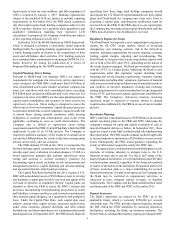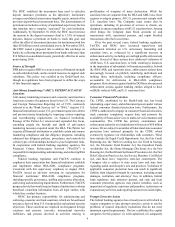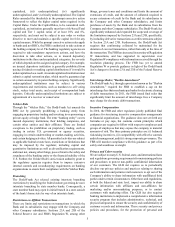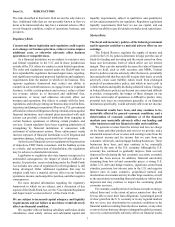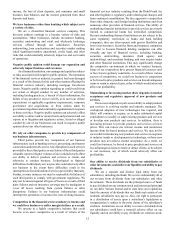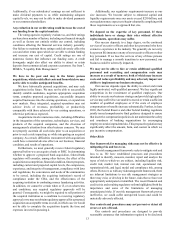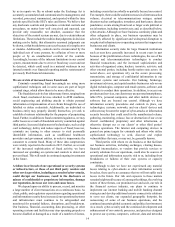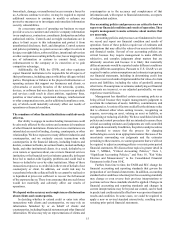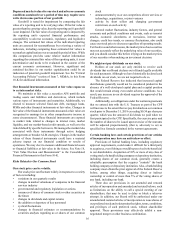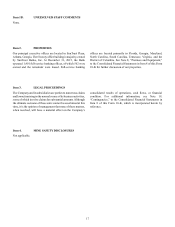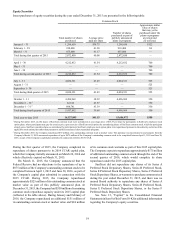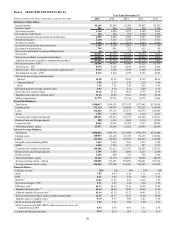SunTrust 2015 Annual Report Download - page 38
Download and view the complete annual report
Please find page 38 of the 2015 SunTrust annual report below. You can navigate through the pages in the report by either clicking on the pages listed below, or by using the keyword search tool below to find specific information within the annual report.10
We may have more credit risk and higher credit losses to the
extent that our loans are concentrated by loan type, industry
segment, borrower type, or location of the borrower or
collateral.
Our credit risk and credit losses can increase if our loans are
concentrated in borrowers engaged in the same or similar
activities or in borrowers who as a group may be uniquely or
disproportionately affected by economic or market conditions.
Deterioration in economic conditions, housing conditions, or
real estate values in the markets in which we operate could result
in materially higher credit losses. For additional information, see
the “Loans,” “Allowance for Credit Losses,” “Risk
Management-Credit Risk Management” and “Critical
Accounting Policies-Allowance for Credit Losses” sections in
the MD&A and Notes 6 and 7, “Loans” and “Allowance for
Credit Losses,” to the Consolidated Financial Statements in this
Form 10-K.
Liquidity Risks
We rely on the mortgage secondary market and GSEs for
some of our liquidity.
We sell most of the mortgage loans that we originate to
reduce our credit risk and to provide funding for additional loans.
We rely on GSEs to purchase loans that meet their conforming
loan requirements. Investor demand for nonconforming loans
has fallen sharply, resulting in decreased origination of non-
conforming loans which reduces our revenue. When we retain a
loan not only do we keep the credit risk of the loan but we also
do not receive any sale proceeds that could be used to generate
new loans. A persistent lack of liquidity could limit our ability
to fund and thus originate new mortgage loans, reducing the fees
we earn from originating and servicing loans. In addition, we
cannot provide assurance that GSEs will not materially limit their
purchases of conforming loans due to capital constraints or
change their criteria for conforming loans (e.g., maximum loan
amount or borrower eligibility). Proposals have been presented
to reform the housing finance market in the U.S., including the
role of the GSEs in the housing finance market. The extent and
timing of any such regulatory reform of the housing finance
market and the GSEs, as well as any effect on our business and
financial results, are uncertain.
Loss of customer deposits could increase our funding costs.
We rely heavily on bank deposits as a low cost and stable
source of funding for the loans we make. We compete with banks
and other financial services companies for deposits. If our
competitors raise the rates they pay on deposits, our funding costs
may increase, either because we raise our rates to avoid losing
deposits or because we lose deposits and must rely on more
expensive sources of funding. Higher funding costs reduce our
net interest margin and net interest income.
Legal Risks
We are subject to litigation, and our expenses related to this
litigation may adversely affect our results.
From time to time we are subject to litigation in the course
of our business. These claims and legal actions, including
supervisory actions by our regulators, could involve large
monetary claims and significant defense costs. During the
2008-2010 financial crisis, we observed both the number of cases
and our expenses related to those cases increase. The outcome
of some of these cases is uncertain.
We establish reserves for legal claims when payments
associated with the claims become probable and the costs can be
reasonably estimated. We may still incur legal costs for a matter
even if we have not established a reserve. In addition, the actual
cost of resolving a legal claim may be substantially higher than
any amounts reserved for that matter. The ultimate resolution of
a pending legal proceeding, depending on the remedy sought and
granted, could materially adversely affect our results of
operations and financial condition.
Substantial legal liability or significant regulatory action
against us could have material adverse financial effects or cause
significant reputational harm to us, which in turn could seriously
harm our business prospects. We may be exposed to substantial
uninsured liabilities, which could adversely affect our results of
operations and financial condition. For additional information,
see Note 19, “Contingencies,” to the Consolidated Financial
Statements in this Form 10-K.
We may incur fines, penalties and other negative
consequences from regulatory violations, possibly even
inadvertent or unintentional violations.
We maintain systems and procedures designed to ensure that
we comply with applicable laws and regulations, but there can
be no assurance that these will be effective. In addition to fines
and penalties, we may suffer other negative consequences from
regulatory violations including restrictions on certain activities,
such as our mortgage business, which may affect our relationship
with the GSEs and may also damage our reputation, and this in
turn might materially affect our business and results of
operations.
For example, on October 10, 2013, we announced that we
reached agreements in principle, and on June 17, 2014 we
announced that we reached definitive agreements, with the HUD
and the U.S. DOJ to settle (i) certain civil and administrative
claims arising from FHA-insured mortgage loans originated by
STM from January 1, 2006 through March 31, 2012 and (ii)
certain alleged civil claims regarding our mortgage servicing and
origination practices as part of the National Mortgage Servicing
Settlement. Pursuant to the combined settlement, we agreed to
pay $468 million. In addition, we agreed to provide $500 million
of consumer relief and to implement certain mortgage servicing
standards.
Further, some legal/regulatory frameworks provide for the
imposition of fines or penalties for noncompliance even though
the noncompliance was inadvertent or unintentional and even
though there were in place at the time systems and procedures
designed to ensure compliance. For example, we are subject to
regulations issued by OFAC that prohibit financial institutions
from participating in the transfer of property belonging to the
governments of certain foreign countries and designated
nationals of those countries. OFAC may impose penalties for
inadvertent or unintentional violations even if reasonable
processes are in place to prevent the violations. Additionally,
federal regulators have begun pursuing financial institutions
with emerging theories of recovery under the Financial
Institutions Reform, Recovery, and Enforcement Act of 1989
(FIRREA). Courts may uphold significant additional penalties





